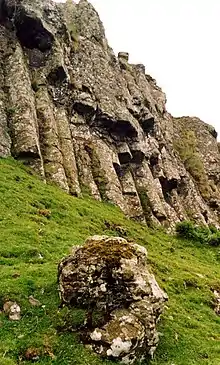 | |
 Dunagoil Shown within Argyll and Bute | |
| Location | Isle of Bute |
|---|---|
| Region | Scotland |
| Coordinates | 55°44′02″N 5°03′04″W / 55.734°N 5.051°W |
| Type | hill fort |
| Length | 300 feet |
| Width | 75 feet |
| History | |
| Material | wood and stone |
| Periods | Iron Age |
Dunagoil is a vitrified fort or dun on the Isle of Bute – an Iron Age hill fort whose ramparts have been melted by intense heat. It stands on a volcanic headland and gives its name to the bay that it overlooks. Like other places, such as Donegal, its name is from the Gaelic dún na gall – fort of the foreigners.[1][2]
References
Citations
- ↑ Canmore 2009.
- ↑ Harding 2004, pp. 90–91, 141–143.
Sources
- Harding, D.W. (2004), The Iron Age in Northern Britain: Celts and Romans, Natives and Invaders, Routledge, ISBN 9781134417872
- "Bute, Dunagoil", Canmore, Historic Environment Scotland, 20 March 2009
This article is issued from Wikipedia. The text is licensed under Creative Commons - Attribution - Sharealike. Additional terms may apply for the media files.